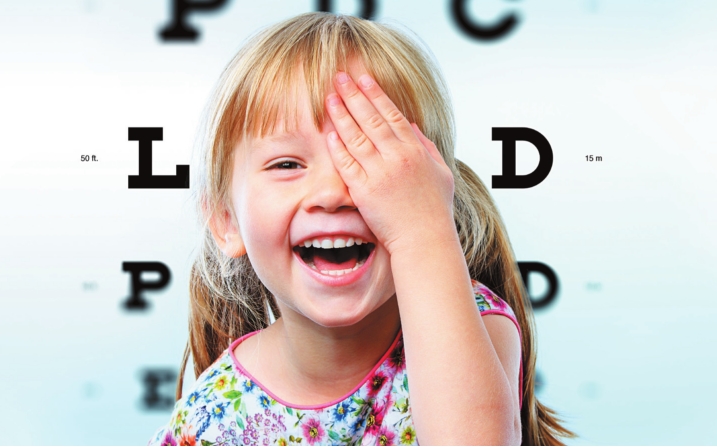GLASSES AND CONTACTS FOR CHILDREN

Determining what’s best for your child
Glasses are needed for a number of children to have proper vision. Without glasses, many children cannot see fully and cannot do as well as they could in school. Sometimes this may contribute greatly to their problems at school, and other times it may have just a small contribution. Other times it may have no bearing on their school work. An eye doctor that is comfortable with children can help make the decision whether the child requires glasses and whether this may help him or her with school.
If a boy or girl is complaining about their vision, they should have a full eye exam. Other symptoms to watch for include squinting, having to move up closer to see objects, and complaints of not being able to focus properly. Some other symptoms that can be related to vision include headaches, dislike of reading, or general difficulty in school. Having these symptoms do not mean that the child needs glasses, but it is a good idea to have your child checked. If glasses are needed, it is something that can make a large difference for the child. The parent should not be discouraged if they are seen by the eye doctor and told that they do not need glasses. At least, this can be marked off from the list of things that could be contributing to the child’s difficulties at school.
If the child needs glasses, there are a large number of styles that the child can choose from. It is best to let the child help decide what type of glasses they would like to wear. A good optician should also be able to give significant help in deciding what type of glasses may work best for a child. The glasses should fit comfortably and have an appearance that the child likes.
 Most
children will wear the glasses well. If they will not wear them, the
first thing that should be done is to make sure that the correct
prescription was ground into the glasses. Most of the time, glasses are
done correctly, but errors can happen. If the glasses are done
correctly, then the parents need to let the eye doctor know that the
child will not wear the glasses. They can then be rechecked to make sure
nothing needs to be changed with the glasses. They can also be checked
to make sure that they truly need glasses.
Most
children will wear the glasses well. If they will not wear them, the
first thing that should be done is to make sure that the correct
prescription was ground into the glasses. Most of the time, glasses are
done correctly, but errors can happen. If the glasses are done
correctly, then the parents need to let the eye doctor know that the
child will not wear the glasses. They can then be rechecked to make sure
nothing needs to be changed with the glasses. They can also be checked
to make sure that they truly need glasses.
Most children should have some refractive error. Children should be slightly hyperopic (far-sighted) and often may have mild astigmatism. Just because this can be measured in children, it does not mean every child needs glasses. I have seen children placed in glasses for normal refractive errors for their age that do not want to wear the glasses and do not improve at school with the glasses. This is because they never needed to be placed in glasses. It has done no damage to the eyes, but it is an extra cost and hassle for the family. It is important for these children to see a professional that is accustomed to examining young children.
Once the child becomes older, he or she may want to begin wearing contacts. I am asked often at what age is it safe to wear contacts. The answer is that it depends on a number of things, and there is no magic number that has to be reached to wear contacts. It depends on the child, his or her maturity, the family, his or her environment, and what type of refractive error the child has. I have children as young as 6 that are able to do well with contacts, and then have teenagers that still are not ready for contacts. If the child is unable to let anyone or anything get close to their eye, they are not ready. If the child is not mature enough, they are not ready. If the child does not want contacts and it is the parent that really wants them to have contacts, they usually will not do well with contacts. Most of these children end up staying in glasses and never wear the contacts anyway.
With glasses, there are no risks of infection, and they can even serve for protection for the eyes. Contacts offer no barrier to protect the eyes and do increase your risk of a corneal infection. All children (along with their parents) who are fitted with contacts should be instructed in detail on how to put them in, take them out and care for them. There are many contacts that are made to sleep in and wear for extended periods of time. I do not suggest doing this with any contacts. It has been shown in multiple studies that your risk of a corneal ulcer increases significantly if you sleep in the contacts. Children should also not swim in contacts. There are a number of bacteria and parasites that can be introduced into the eye by doing this.
If contacts are done correctly, they can be extremely rewarding for the child to get a break from their glasses. If contacts are not done correctly, children can develop a corneal ulcer that can ultimately (even with treatment) lead to a blind, painful eye. This is not meant to scare away the use of contacts, but parents and children need to know that wearing contacts do require responsibility and have risks involved.
Dr. John D. Hinrichsen is a pediatric ophthalmologist / strabisumus specialist at Highland Clinic who devotes his practice toward the diagnosis and treatment of eye problems in children. He specializes in the treatment of strabismus, amblyopia, ptosis and nystagmus. He can be reached at (318) 222-8402, at 1455 East Bert Kouns Industrial Loop, Suite 103, Shreveport, LA. Web site http://www.highlandclinic.com/staff/john-hinrichsen-md .
